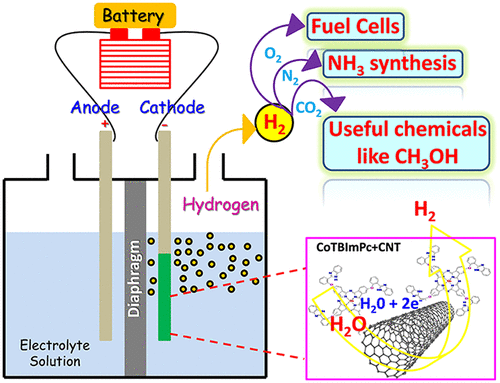当前位置:
X-MOL 学术
›
ACS Appl. Energy Mater.
›
论文详情
Our official English website, www.x-mol.net, welcomes your feedback! (Note: you will need to create a separate account there.)
Bioinspired Precious-Metal-Free N4 Macrocycle as an Electrocatalyst for the Hydrogen Evolution Reaction
ACS Applied Energy Materials ( IF 6.4 ) Pub Date : 2021-09-17 , DOI: 10.1021/acsaem.1c01796 Sowmyashree Hadimane 1 , Shambhulinga Aralekallu 1 , Keshavananda Prabhu CP 1 , Mirabbos Hojamberdiev 2, 3 , Lokesh Koodlur Sannegowda 1
ACS Applied Energy Materials ( IF 6.4 ) Pub Date : 2021-09-17 , DOI: 10.1021/acsaem.1c01796 Sowmyashree Hadimane 1 , Shambhulinga Aralekallu 1 , Keshavananda Prabhu CP 1 , Mirabbos Hojamberdiev 2, 3 , Lokesh Koodlur Sannegowda 1
Affiliation

|
The design and development of strategies and catalysts are essential for sustainable energy production, particularly for the hydrogen evolution reaction (HER). Precious Pt/C catalyst is known to demonstrate high efficiency in the electrochemical HER and suffers from commercialization issues. Therefore, precious-metal-free and organic-based catalysts are of importance for a future perspective. In this work, cobalt tetra[4-[2-(1H-benzimidazol-2-yl)phenoxy]]phthalocyanine (CoTBImPc) is synthesized for the first time and characterized by physicochemical and electrochemical techniques. 1H NMR and mass spectral data reveal the successful formation of the ligand and complex, whereas the thermogravimetry (TG) study confirms the thermal stability of the complex up to 400 °C. The electroactivity of CoTBImPc is compared with the hybrid composite of a carbon nanotube (CNT-CoTBImPc) and benchmark Pt/C catalyst for the HER. Linear sweep voltammetry (LSV) shows that an onset potential for the HER for CoTBImPc-CNT/GCE is shifted to a higher potential than that of CoTBImPc/GCE, suggesting that the HER is more feasible at the surface of CoTBImPc-CNT. Higher activity for CoTBImPc-CNT/GCE in comparison with that of CoTBImPc/GCE in 0.5 M H2SO4 (pH = 0.3) may be ascribed to the enhanced conductivity, a greater number of active sites, and a larger surface area. The hybrid composite yields a current density of −10 mA·cm–2 and demonstrates HER activity at a lower overpotential (63 mV). The benchmark Pt/C catalyst and the as-synthesized pristine phthalocyanine molecule exhibit the HER at overpotentials of 3 and 160 mV, respectively, at a current density of −10 mA·cm–2. A lower Tafel slope value of 43.2 mV·dec–1 and a higher double-layer capacitance value of 44 mF·cm–2 confirm that the hybrid composite is one of the superior catalyst candidates for the HER compared to the bare glassy carbon electrode (GCE) and pristine metal phthalocyanine. Further, CoTBImPc-CNT/GCE also exhibits an excellent stability during the HER.
中文翻译:

仿生无贵金属 N4 大环化合物作为析氢反应的电催化剂
策略和催化剂的设计和开发对于可持续能源生产至关重要,特别是对于析氢反应 (HER)。众所周知,贵重 Pt/C 催化剂在电化学 HER 中表现出高效率,但存在商业化问题。因此,无贵金属和有机基催化剂对于未来的前景非常重要。在这项工作中,首次合成了四[4-[2-(1 H-苯并咪唑-2-基)苯氧基]]酞菁钴( CoTBImPc ),并通过物理化学和电化学技术对其进行了表征。1H NMR 和质谱数据揭示了配体和配合物的成功形成,而热重 (TG) 研究证实了配合物的热稳定性高达 400 °C。将CoTBImPc的电活性与碳纳米管 ( CNT-CoTBImPc ) 和用于 HER 的基准 Pt/C 催化剂的混合复合材料进行比较。线性扫描伏安法 (LSV) 显示CoTBImPc -CNT/GCE的 HER 起始电位转移到比CoTBImPc /GCE更高的电位,表明 HER 在CoTBImPc -CNT表面更可行。在 0.5 MH 2 SO 中,与CoTBImPc /GCE相比,CoTBImPc-CNT/GCE 的活性更高4 (pH = 0.3) 可能归因于增强的导电性、更多的活性位点和更大的表面积。混合复合材料产生 -10 mA·cm –2的电流密度,并在较低的过电位 (63 mV) 下显示出 HER 活性。基准 Pt/C 催化剂和合成的原始酞菁分子在 -10 mA·cm –2的电流密度下分别在 3 和 160 mV 的过电位下表现出 HER 。较低的 Tafel 斜率值 43.2 mV·dec –1和较高的双层电容值 44 mF·cm –2证实与裸玻碳电极 (GCE) 和原始金属酞菁相比,混合复合材料是 HER 的优良催化剂候选者之一。此外,CoTBImPc-CNT/GCE 在 HER 过程中也表现出优异的稳定性。
更新日期:2021-10-25
中文翻译:

仿生无贵金属 N4 大环化合物作为析氢反应的电催化剂
策略和催化剂的设计和开发对于可持续能源生产至关重要,特别是对于析氢反应 (HER)。众所周知,贵重 Pt/C 催化剂在电化学 HER 中表现出高效率,但存在商业化问题。因此,无贵金属和有机基催化剂对于未来的前景非常重要。在这项工作中,首次合成了四[4-[2-(1 H-苯并咪唑-2-基)苯氧基]]酞菁钴( CoTBImPc ),并通过物理化学和电化学技术对其进行了表征。1H NMR 和质谱数据揭示了配体和配合物的成功形成,而热重 (TG) 研究证实了配合物的热稳定性高达 400 °C。将CoTBImPc的电活性与碳纳米管 ( CNT-CoTBImPc ) 和用于 HER 的基准 Pt/C 催化剂的混合复合材料进行比较。线性扫描伏安法 (LSV) 显示CoTBImPc -CNT/GCE的 HER 起始电位转移到比CoTBImPc /GCE更高的电位,表明 HER 在CoTBImPc -CNT表面更可行。在 0.5 MH 2 SO 中,与CoTBImPc /GCE相比,CoTBImPc-CNT/GCE 的活性更高4 (pH = 0.3) 可能归因于增强的导电性、更多的活性位点和更大的表面积。混合复合材料产生 -10 mA·cm –2的电流密度,并在较低的过电位 (63 mV) 下显示出 HER 活性。基准 Pt/C 催化剂和合成的原始酞菁分子在 -10 mA·cm –2的电流密度下分别在 3 和 160 mV 的过电位下表现出 HER 。较低的 Tafel 斜率值 43.2 mV·dec –1和较高的双层电容值 44 mF·cm –2证实与裸玻碳电极 (GCE) 和原始金属酞菁相比,混合复合材料是 HER 的优良催化剂候选者之一。此外,CoTBImPc-CNT/GCE 在 HER 过程中也表现出优异的稳定性。



























 京公网安备 11010802027423号
京公网安备 11010802027423号